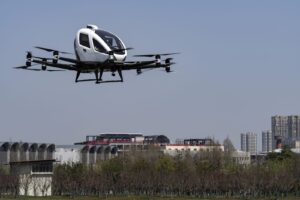China pioneers low-Altitude economy with cargo drones and air taxis
Through the testing of air taxis and freight drones, China is leading the way in the low-altitude economy.

A larger initiative is underway to utilize low-altitude airspace (below 1,000 meters) for logistical and commercial purposes, of which this development is a component. Short-haul freight and passenger transportation is being tried through the use of electric vertical takeoff and landing (eVTOL) aircraft and unmanned aerial vehicles (UAVs).
Drones carrying cargo are thought to be able to increase the effectiveness of logistics, especially when it comes to transporting supplies to hard-to-reach or isolated locations. They might shorten delivery times and lower expenses, making supply chains more flexible. Conversely, air taxis are a futuristic kind of urban transportation that might reduce traffic jams and enable quicker city transit.
China is pursuing its objectives of leading the world in drone technology and encouraging innovation in the transportation sector by concentrating on these technologies. If cargo drones and air taxis are successfully integrated, it has the potential to completely transform urban mobility, logistics, and the low-altitude economy as a whole, putting China at the forefront of this rapidly developing sector.
The economic and logistical exploitation of airspace below 1,000 meters is known as China’s “low-altitude economy.” This area, which was previously underutilized a lot, is now recognized as a vital resource that can spur technical advancement and economic prosperity. This airspace has a wide range of possible uses, from quick urban transit to shipping commodities to far-flung locations.
The core of this low-altitude revolution are cargo drones. These unmanned aerial vehicles (UAVs) are undergoing trials because of their exceptional speed and efficiency in delivering items over short distances. Picture a future in which packages arrive at your house via drone rather than regular delivery methods. In China, this is not a far-off dream but a quickly materializing reality.
The capacity of cargo drones to access difficult-to-reach or inaccessible locations is one of its biggest benefits. Cargo drones may significantly cut delivery times and expenses, whether they are used to bring necessities to an isolated settlement or medical supplies to a village in the highlands. The flexibility of supply chains is especially important in emergency scenarios where prompt delivery can save lives.
Furthermore, cargo drones have a smaller environmental impact than regular delivery vehicles. Drones are a greener alternative that aligns with global efforts to tackle climate change, as they emit less and rely less on fossil fuels.




